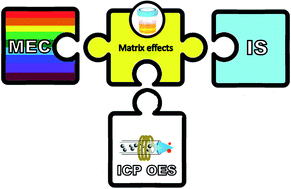Calibration strategies to correct for matrix effects in direct analysis of urine by ICP OES: internal standardization and multi-energy calibration†
Abstract
This study investigated internal standardization and multi-energy calibration (MEC) as strategies for direct analysis of urine by inductively coupled plasma optical emission spectrometry (ICP OES). Gallium, Ge, Pd, Sc and Y were evaluated as internal standards (ISs) for determination of Al, As, Ba, Be, Bi, Ca, Cd, Co, Cr, Cu, Hg, K, Li, Mg, Na, Pb, Sb and Zn in urine. The accuracy and precision were evaluated by addition–recovery experiments and the best results were obtained when Ge or Pd was used as IS. Recoveries ranged from 80 to 120% and relative standard deviations for all elements and samples were lower than 7.5%, except in the case of the lowest analyte levels (0.025 and 0.050 mg L−1). Recoveries varying from 80 to 120% were obtained only for the highest levels tested (>4.0 mg L−1) when using MEC. The LODs obtained by internal standardization were lower than the LODs obtained by MEC. Both calibration methods were suitable to correct for matrix effects, making feasible the direct analysis of urine by ICP OES, without any sample preparation.

- This article is part of the themed collection: Analytical Methods Recent HOT articles


 Please wait while we load your content...
Please wait while we load your content...